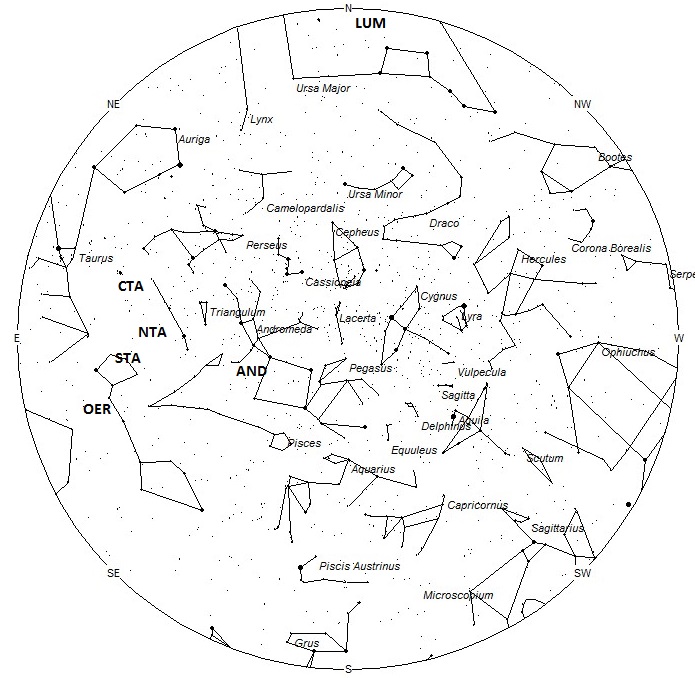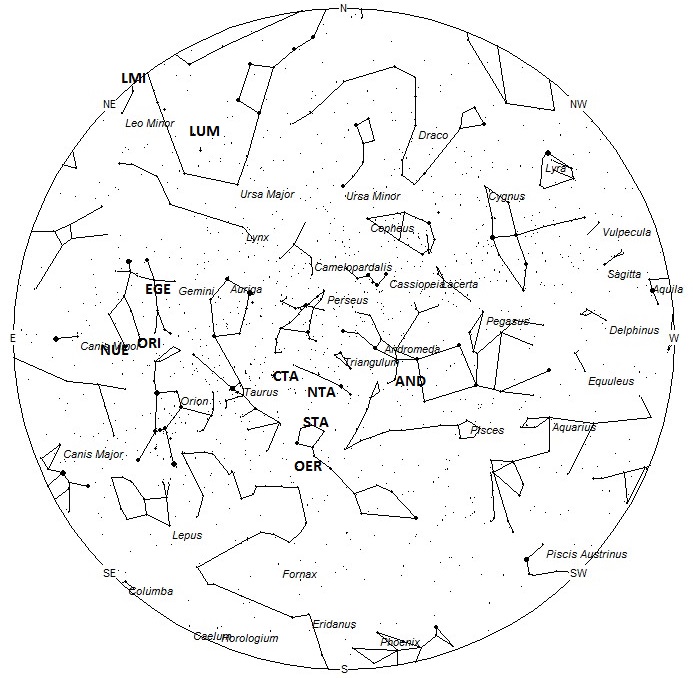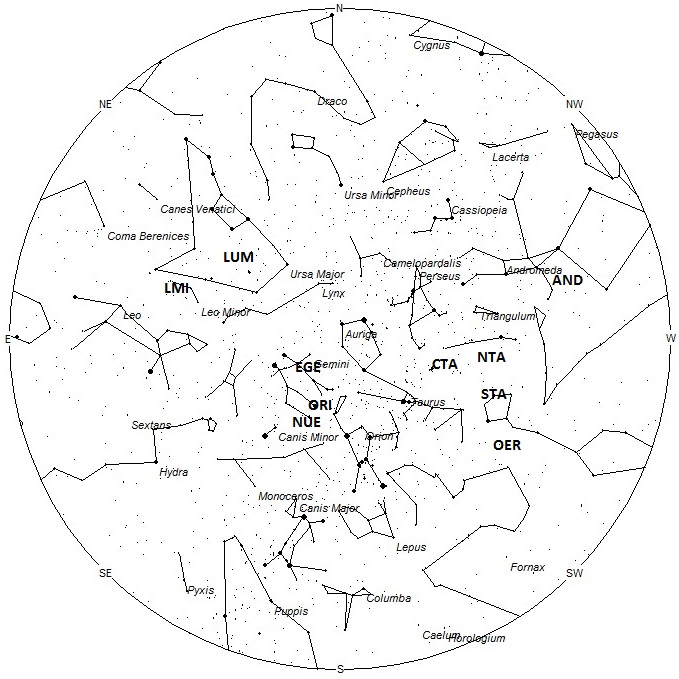
During this period the moon will reach its first quarter phase on Friday October 27th. At this time the moon will be located 90 degrees east of the sun and will set near midnight local daylight saving time (LDT) for observers viewing from mid-northern latitudes. This weekend the waxing crescent moon will set shortly after dusk and will not interfere with meteor observing the remainder of the night. The estimated total hourly meteor rates for evening observers this week is near 4 for those viewing from the northern hemisphere and 3 for those located south of the equator. For morning observers the estimated total hourly rates should be near 40 as seen from mid-northern latitudes and 35 from the southern tropics. The actual rates will also depend on factors such as personal light and motion perception, local weather conditions, alertness and experience in watching meteor activity. Note that the hourly rates listed below are estimates as viewed from dark sky sites away from urban light sources. Observers viewing from urban areas will see less activity as only the brighter meteors will be visible from such locations.
The radiant (the area of the sky where meteors appear to shoot from) positions and rates listed below are exact for Saturday night/Sunday morning October 21/22. These positions do not change greatly day to day so the listed coordinates may be used during this entire period. Most star atlases (available at science stores and planetariums) will provide maps with grid lines of the celestial coordinates so that you may find out exactly where these positions are located in the sky. A planisphere or computer planetarium program is also useful in showing the sky at any time of night on any date of the year. Activity from each radiant is best seen when it is positioned highest in the sky, either due north or south along the meridian, depending on your latitude. It must be remembered that meteor activity is rarely seen at the radiant position. Rather they shoot outwards from the radiant so it is best to center your field of view so that the radiant lies at the edge and not the center. Viewing there will allow you to easily trace the path of each meteor back to the radiant (if it is a shower member) or in another direction if it is a sporadic. Meteor activity is not seen from radiants that are located far below the horizon. The positions below are listed in a west to east manner in order of right ascension (celestial longitude). The positions listed first are located further west therefore are accessible earlier in the night while those listed further down the list rise later in the night.
These sources of meteoric activity are expected to be active this week.
.
The first activity from the Andromedids (AND) should be seen this week. This is a famous shower that produced some brilliant displays during the 19th century. Since then the main orbit of the particles from comet 3D/Biela have moved away from the Earth. Still, remnants may be seen from October 26 through November 17 with maximum activity occurring on November 5. The radiant is currently located at 00:28 (007) +23, which lies in southwestern Andromeda, 7 degrees southeast of the 2nd magnitude star known as Alpheratz (alpha Andromedae). Rates would most likely be less than 1 per hour no matter your location. The radiant is best located near midnight LDT when the radiant lies highest above the horizon. With an entry velocity of 18 km/sec., the average Andromedid meteor would be of slow velocity.
The Northern Taurids (NTA) are active from a large radiant located at 02:30 (038) +18. This area of the sky is located in central Aries, 6 degrees southeast of the 2nd magnitude star known as Hamal (alpha Arietis). This position is very close to the Southern Taurids so great care must be taken in separating these meteors. You must have the two radiants near the center of your field of view to properly differentiate these sources. Current rates would be 2 per hour as seen from the northern hemisphere and 1 per hour as seen from south of the equator. These meteors may be seen all night long but the radiant is best placed near 0200 LDT when it lies on the meridian and is located highest in the sky. With an entry velocity of 28 km/sec., the average Northern Taurid meteor would be of slow velocity.
The Southern Taurids (STA) are active from a large radiant centered near 02:44 (041) +11. This position lies in southern Aries, just 1 degree north of the 4th magnitude star known as mu Ceti. These meteors may be seen all night long but the radiant is best placed near 0200 LDT when it lies on the meridian and is located highest in the sky. Rates at this time should be near 3 per hour regardless of your location. With an entry velocity of 27 km/sec., the average Southern Taurid meteor would be of slow velocity.
The omicron Eridanids (OER) were discovered by Japanese observers using video data from SonotoCo in 2007-2008. This is a weak shower that usually produces rates less than 1 per hour, even at maximum activity. The radiant is currently located at 02:48 (042) -04, which places it in western Eridanus , 5 degrees southeast of the 4th magnitude star known as delta Ceti. This location is close to the source of the Southern Taurids so care must be taken to separate these meteors. Like the STA’s these meteors may be seen all night long but the radiant is best placed near 0200 LDT when it lies on the meridian and is located highest in the sky. With an entry velocity of 29 km/sec., the average omicron Eridanid meteor would be of slow velocity.
The chi Taurids (CTA) were discovered by Dr. Peter Brown during his 7 year survey using the Canadian Meteor Orbit Radar (CMOR). This source is active from October 20 through November 17 with a maximum occurring near November 3rd. Current rates would be less than 1 per hour no matter your location. The radiant is currently located at 03:20 (050) +24, which places it in eastern Aries , 5 degrees west of the famous naked eye open cluster known as the Pleiades. This location is close to the source of the Northern Taurids so care must be taken to separate these meteors. These meteors may be seen all night long but the radiant is best placed near 0300 LDT when it lies on the meridian and is located highest in the sky. With an entry velocity of 41 km/sec., the average chi Taurid meteor would be of medium velocity.
The Orionids (ORI) reach maximum activity this weekend from a radiant located at 06:24 (096) +16, which places it on the Orion/Gemini border, 2 degrees west of the 2nd magnitude star known as Alhena (gamma Geminorum). This area of the sky is best placed in the sky near 0500 LDT, when it lies highest above the horizon in a dark sky. Rates this weekend should be near 20 per hour no matter your location. Rates will slowly dwindle as the week progresses. With an entry velocity of 67 km/sec., most activity from this radiant would be of swift speed.
The nu Eridanids (NUE) were co-discovered by Japanese observers using SonotoCo and Juergen Rendtel and Sirko Molau of the IMO. Activity from this long-period stream stretches from August 24 all the way to November 16. A very shallow maximum occurred near September 8. The radiant currently lies at 06:54 (104) +12, which places it in southwestern Gemini, just southeast of the 3rd magnitude star known as Alzirr (xi Geminorum). This area of the sky is best seen during the last dark hour before dawn when the radiant lies highest in a dark sky. This position is also close the the Orionid radiant and some experts feel that these two sources are related. To separate any possible nu Eridanids from the much stronger Orionids one must face in a direction so that both radiant are well within your field of view. Current rates are expected to be less than 1 per hour during this period no matter your location. With an entry velocity of 67 km/sec., the average meteor from this source would be of swift velocity.
The epsilon Geminids (EGE) are active from a radiant located at 07:04 (106) +28. This position lies in central Gemini, 2 degrees southwest of the 4th magnitude star known as tau Geminorum. This area of the sky is best seen during the last dark hour before dawn when the radiant lies highest in a dark sky. Expected hourly rates would be less than 1 per hour this week no matter your location. With an entry velocity of 70 km/sec., the average meteor from this source would be of swift velocity.
The Lambda Ursae Majorids (LUM) are a recent discovery by Željko Andreić and the Croatian Meteor Network team based on studying SonotaCo and CMN observations (SonotaCo 2007-2011, CMN 2007-2010). This weak shower is active from October 24 through November 1st with maximum activity occurring on the 27th. At maximum the radiant is located at 10:24 (156) +49. This position lies in a sparse area of central Ursa Major, between the 2nd magnitude star Merak (Beta Ursae Majoris) and 3rd magnitude Tania Borealis (Lambda Ursa Majoris). This area of the sky is best placed in the sky during the last hour before dawn, when it lies highest above the horizon in a dark sky. Rates at maximum should be near 1 per hour as seen from the northern hemisphere and less than 1 as seen from south of the equator. With an entry velocity of 62 km/sec., most activity from this radiant would be of swift speed.
The Leonis Minorids (LMI) are active from October 12-Nov 5 with maximum activity occurring on October 22nd. This radiant is currently located at 10:40 (160) +37, which places it in northwestern Leo Minor, 2 degrees east of the 3rd magnitude star known as beta Leonis Minoris. The radiant is best placed just before dawn when it lies highest in a dark sky. This shower is better situated for observers situated in the northern hemisphere where the radiant rises far higher into the sky before the start of morning twilight. Current rates would be near 3 per hour for observers viewing from the northern hemisphere and less than 2 for those located south of the equator. At 62km/sec., the average Leonis Minorid is swift. From my personal experience this minor shower produces a high proportion of bright meteors.
As seen from the mid-northern hemisphere (45N) one would expect to see approximately 10 sporadic meteors per hour during the last hour before dawn as seen from rural observing sites. Evening rates would be near 3 per hour. As seen from the tropical southern latitudes (25S), morning rates would be near 7 per hour as seen from rural observing sites and 2 per hour during the evening hours. Locations between these two extremes would see activity between the listed figures.
The list below offers the information from above in tabular form. Rates and positions are exact for Saturday night/Sunday morning except where noted in the shower descriptions.
| SHOWER | DATE OF MAXIMUM ACTIVITY | CELESTIAL POSITION | ENTRY VELOCITY | CULMINATION | HOURLY RATE | CLASS |
| RA (RA in Deg.) DEC | Km/Sec | Local Daylight Saving Time | North-South | |||
| Andromedids (AND) | Nov 05 | 00:28 (007) +23 | 18 | 00:00 | <1 – <1 | III |
| Northern Taurids (NTA) | Nov 02 | 02:30 (038) +18 | 28 | 02:00 | 2 – 1 | II |
| Southern Taurids (STA) | Oct 29-Nov 03 | 02:44 (041) +11 | 27 | 02:00 | 3 – 3 | II |
| omicron Eridanids (OER) | Nov 04 | 02:48 (042) -04 | 29 | 02:00 | <1 – <1 | IV |
| chi Taurids (CTA) | Nov 03 | 03:20 (050) +24 | 41 | 03:00 | <1 – <1 | IV |
| Orionids (ORI) | Oct 22 | 06:24 (096) +16 | 67 | 05:00 | 20 – 20 | I |
| nu Eridanids (NUE) | Sep 08 | 06:54 (104) +12 | 67 | 06:00 | <1 – <1 | IV |
| epsilon Geminids (EGE) | Oct 11 | 07:04 (106) +28 | 70 | 06:00 | <1 – <1 | II |
| Lambda Ursae Majorids (LUM) | Oct 27 | 10:24 (156) +49 | 62 | 11:00 | 1 – <1 | IV |
| Leonis Minorids (LMI) | Oct 22 | 10:40 (160) +37 | 62 | 11:00 | 3 – 2 | II |
 American Meteor Society
American Meteor Society



I was out early last night, but too early to have very good rates, for the pre-maximum Orionids.
However, from 12:03 AM to 02:03 AM EDT I was able to see 14 Orionids. There was only 3
Orionids seen the 1st hour, but the rates picked up the 2nd hour to 11 per hour. The best one
seen was a nice O magnitude yellow Orionid with a 3 second train seen at 1:45 AM EDT. The
transparency was excellent both hours with a LM-6.5.
Starry Skies,
GWG
Screech Owl Hill Observatory
Mathias, West Virginia
I am a newbie, and not versed in terminology (although this web site looks like a good starting point to learn more). I walk my dog early in the morning and also in the evening about 8 pm. I live in SE Michigan. 2 or 3 weeks ago I saw the most beautiful morning meteoroid, with the “trail of sparks” that makes it look like a firework (minus the big display at the end). Much slower than a “shooting star”, and I swore I could see a trail of sparks and it might have lasted for a second or a second and a quarter? it was in the morning and traveled SW to NE, right above Orion and Taurus, all the way to the Subaru/Pleaides stars. Just beautiful.
Then, Friday night, Nov. 10th, I was out about 8 pm and observed another beautiful display, again with the spark trail and also seeming to break up at the end. It seemed to travel north to south, starting around Caciopea maybe… Then again tonight, although the sky was hazy, the brighter stars were barely visible and whoom! again from SW to NE, with a trail of sparks and again with the breaking up at the end. It even gave the appearance of a glow to the haze/thin fog in the sir.
I’ve seen dozens upon dozens of shooting stars… why all of a sudden with these beautiful meteoroids?
Hi Jeff and All,
We are in the midst of the Taurid meteor shower, known to produce bright and vividly colored fireballs. This should continue for another month and then decline suddenly after mid-December.
Robert Lunsford